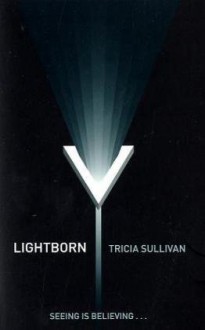
It’s tricky when a trilogy’s middle book is your favorite – how do you recommend something that in no way stands alone? But this was the book where the trilogy worked its magic on me, taking over my life for at least a week, and these days the books that can pull me in so thoroughly are few and far between. Still, it’s tempting to just call it magic because it's hard to explain why a book that would seem like a typical work of genre fantasy to most readers worked so well for me.
Lightborn picks up where Darkborn left off, but uses the risky technique of dividing the prior book’s point-of-view characters – now geographically distant and pursuing two distinct storylines – into separate books, so that this one focuses on events in the city and leaves Balthasar and Ishmael in the Borderlands for the sequel. In addition to Telmaine, we have three new POV characters: Floria (who turns out to be more food taster than assassin – to my relief, as assassins have been done to death in fantasy); Fejelis, a Lightborn prince; and Tam, a mage and Fejelis’s mentor. This volume also shifts from the prior book's tight focus on the protagonists’ adventures and romances to a larger story of political intrigue encompassing two parallel kingdoms.
And while the political intrigue might first seem all stylized dialogue and far too many new characters (Sinclair introduces characters willy-nilly in the last two books – more than she can use, which is a shame, since many are potentially fascinating), this is where the book shines. The Shadowborn, our requisite evil villains, are never very interesting, but the human conflict is, and there’s a lot of that: hardliners and peacemakers, mages and non-mages, Darkborn and Lightborn. The book’s best moments come from the inevitable conflict between two sympathetic groups who are fundamentally isolated from one another. Take, for instance, this ominous declaration:
“My lords . . . on the other side of sunrise there are powers we do not understand, powers that may exceed anything we can match, and whose motives are unclear.”
Standard fantasy speech . . . if it referred to the villains. Not only does it not, it could come from either Darkborn or Lightborn with equal right. It’s when these groups are pitted against one another, through the actions of a few warmongers and of well-intentioned people working with limited information, that we see genuine suspense and real consequences. This is the closest I’ve seen fantasy come to a portrayal of the lead-up to a modern war.
(It’s a shame Sinclair remembers by the third book who the villains are, and has Darkborn and Lightborn treat each other with a degree of trust and goodwill that, under the circumstances, would be extraordinary even among humans who can actually meet face-to-face.)
Inexplicably, none of the Lightborn ever interpret the attack on the mage tower as an attempt at genocide, despite the fact that they require artificial light to survive even a few moments in darkness, and that magic dies with the mage. So wiping out the mages would be lights out, literally, for the entire race. That the Darkborn hardliners never pause to consider this makes sense, because hardliners generally do fail at cultural differences; that the Lightborn themselves respond only with modest outrage lacks credibility.
Otherwise, this is a fun fantasy book, with a swiftly-moving plot, entertaining characters and some unique worldbuilding. The introduction to Lightborn society is enjoyable; I especially liked the enchanted lights that function like solar panels. There’s a high number of interesting female characters who interact with one another, although the major players are primarily male. There are a few great character moments as our protagonists begin to come into their own. This is not great literature, and on several occasions characters' reactions to events make more sense viewed through the prism of plot than that of actual human psychology. But I started the third book right away, so this one must have done something right.

 Log in with Facebook
Log in with Facebook 






